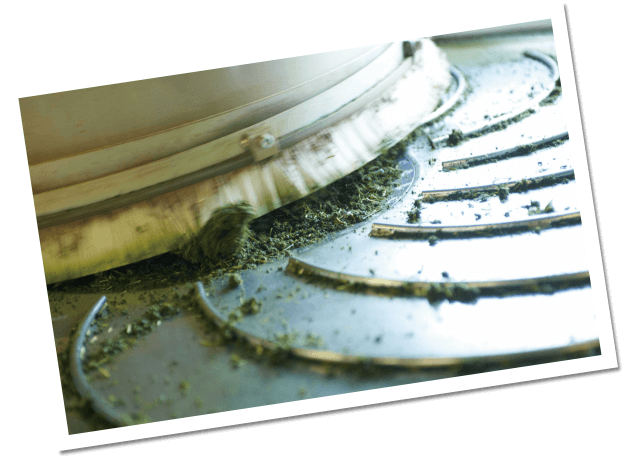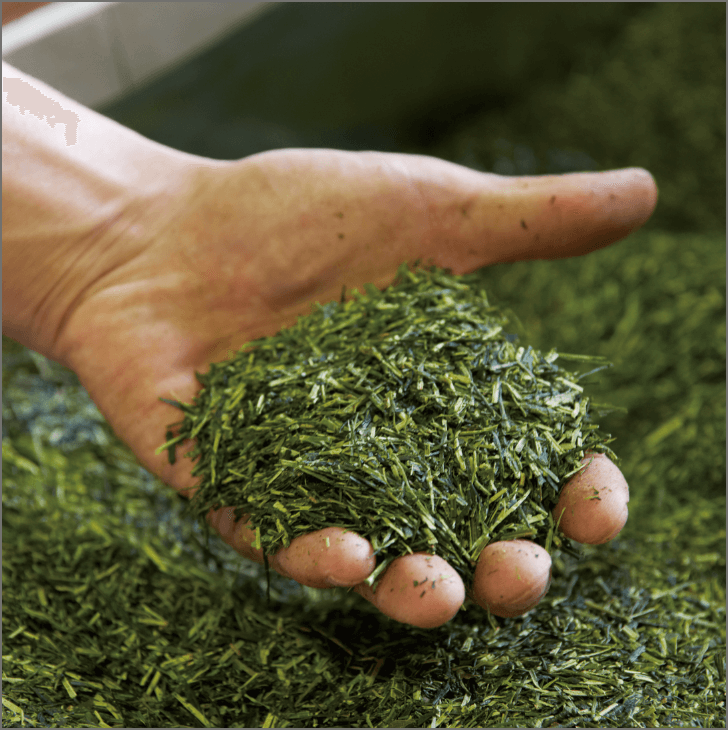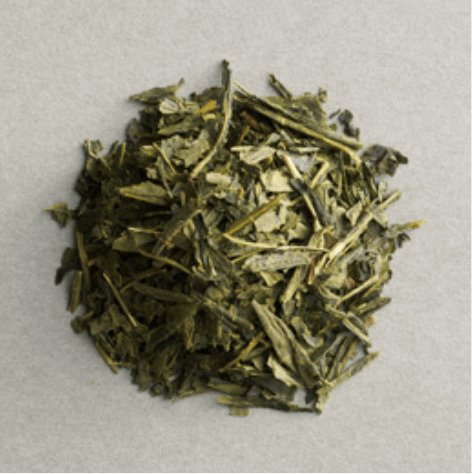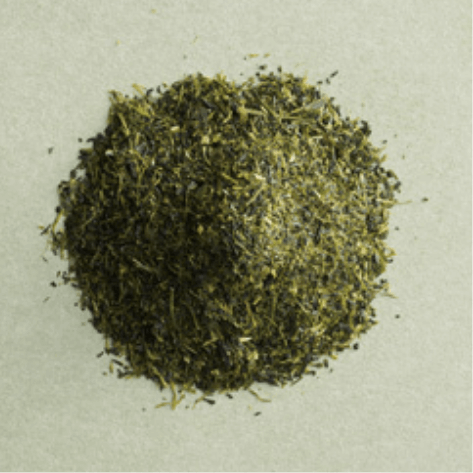Dried tea leaves manufacturing process
By steaming the freshly picked raw tea leaves immediately, it prevents oxidation (fermentation) and preserves the color and aroma of green tea.
The first step for making fine quality tea is to build a good tea plantation and harvest good quality raw tea leaves. When picking tea leaves by machine, only upper portion are cut to pick only sprout. When picking small amount by hand, even higher quality of raw tea leaves are picked as we can distinguish soft portion of sprout.

If the picked raw tea leaves are left as they are, they immediately begin to heat up and burn (its color change to brown and generate odor) as they are breathing. To prevent heat accumulation, we store them in raw tea leave container. At the time of throwing leaves to the container, humid air is sent. After that, fanning and windless are repeated at regular intervals. With this process, leaves maintain their moisture and lower the heat from fresh leaves.

We adjust the length of time for steaming depending on the condition of raw tea leaves. We spread leaves thinly not to be piled up and steam it evenly. After checking the condition and aroma of steamed leaves, we make a subtle adjustment again. We let our experience and the five senses act to check the aroma, color, and the touch and color of water when smashed leaves by hand.

If steamed raw tea leaves are left as they are at high temperature, its bright color, flavor and aroma are lost. To prevent it, air is blown over the steamed leaves to cool them to normal room temperature and preserve the leave’s color, flavor and aroma.

Leaves are beaten to maintain its color, flavor and aroma, and to shorten primary drying and rolling stage which leads to maintaining of freshness of tea leaves. The leaves are beaten as dry hot air is sent to remove steam dew from the leaves’ surface and increase the drying effect.
By rolling tea leaves in the blowing hot air and applying pressure, moisture of tea leaves are evaporated evenly and effectively. We pay attention to the air volume and the humidity to prevent breaking of leaves by drying the surface of leaves.

This crumpling up is the only process which does not apply heat. As the stem and inside of leaves are not easily dried compared to the surface of leaves, we squeeze out the moist and make the moisture of tea leaves evenly.

Since tea leaves after crumpling up process are still relatively high in moisture and uneven in size and shape, they are rolled while dried with hot air to make it thinner. The moisture of tea leaves are dried by this process and the weight of tea leaves decrease to about one third of original weight.
Final drying and rolling is to align the shapes by rolling with adding pressure. We remove the moisture evenly by drying and make the tea leaves long and thin by twisting. At the end of this process, the tea leaves are in condition to fall from the hand quickly.

Tea leaves are exposed to hot wind and dried. At first when tea leaves have moisture, wind temperature is lower and air volume is stronger. As moistures of tea leaves become less, wind temperature is adjusted to higher and air volume is reduced. At this last stage of process, the moisture content is to be approximately 5% and the aroma and flavor are enhanced.

Finished tea processing
Because dried tea leaves are still uneven in shape and the size, we sort out by classes.
By heating, we bring up the aroma and flavor of the tea and blend it in the final finished tea process.

Dried tea leaves are sorted out to several parts by machine. Why do we need to sort? It is to bring out the characteristic of tea. For example, powder-like fine leaves block the tea strainer of the teapot, or if fuzzy leaves are included in finished tea, it lowers the flavor and its appearance. It is why we sort out by classes.

Out of those sorted out leaves, mainly Kagoshita and bud tea become finished tea. As Kagoshita include some stems, it is run in color sorting machine and exclude white stem parts. Thereby the appearance of Kagoshita’s dark green color is enhanced.

Mainly Kagoshita and bud tea go through drying (heating) process.
By lowering the moisture content to 3% from 5% of dried tea leaves,
it improves the preservative effect. Right after Kagoshita and bud tea are dried, they are naturally cooled and blown the air by fan machine to exclude light weight small parts. Color, flavor and aroma are enhanced by using heavy weight parts which include a lot of tea ingredients.

Generally, Kagoshita and bud tea are blended to be finished tea. Tea leaves have different characteristics depending on timing of harvest, location, breed and finished condition of dried tea leaves. We put our passion for blending to pull out the characteristics of the tea.
Efficacy

- Tea catechin is expected to be effective for restraint of the mutation of the cancer cell, restraint of progress stage, acceleration of the self-extinction of the cancer cell, restraint of metastasis and restraint of vascularization.

- Tea catechin is considered to provide the restraint of the rise in blood pressure. Especially, Gabaron tea is said to be high in the effect.
- Tea catechin restraint the rise of LDL cholesterol level and increase HDL cholesterol level. It is said that it is good to drink tea while taking a break or with a meal.

- Sencha has a lot of vitamin C which relieves fatigue and enhances metabolism effect.
- Tea catechin is expected to restraint the increase of influenza virus.
- It is said that a sore throat, mucus and symptom of the cough are suppressed by gargling with tea.

- It is said that methylation catechin which is included in green tea is effective for improvement of the allergic symptom. Because much methylation catechin is included in “benifuuki”, the kind of tea, it reduces the itch of eyes and nosel congestion related to hay fever.

- Caffeine is included in green tea and is effective for sleepiness and improvement of fatigue feeling. Its immediate effect after drinking tea is recognized.
- Theanine which is an amino acid peculiar to tea is said to have tendency to reduce blood pressure and also relaxation effect.
- Tea cathecin is said to prevent the neuronal damage, and theanine is expected to have effect for preventing dementia.e

- When taking green tea catechin with a meal, sugar accumulation to the body decreases, and as a result fat formed from sugar decreases. Therefore, it is expected to have a diet effect.
- As catechin is included in green tea, when drinking tea in about 20 minutes before exercise, the body fat becomes easy to burn. As a result, it enhances diet effect.
- Green tea includes dietary fiber and it is said to enhance bowel movement.

- Catechin, flavonol and chlorophyll included in green tea provide deodorization effect through the absorption and other reaction of the bad smell material.
- Green tea extract and catechin is said to have an effect to restraint the increase of cavity bacteria.

- It is said that green tea catechin increases good bacteria inhabiting in the intestine and decreases bad bacteria.
- It is said that green tea catechin has antibacterial action for enterohemorrhagic escherichia coli 0-157 epidemic, and antipoison action for the verotxin.





































